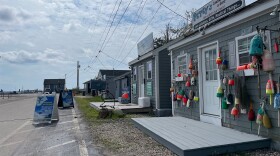The patient is out cold.
At 30 inches from snout to tail, it’s propped on its back, upside down, on a folding table.
Four people lean over it, ready with scalpels, sutures — and penetrating questions about the recent behavior and long-term future of two important species of fish.
Brian Prendergast, research fellow for the Marine Biological Laboratory of Woods Hole, begins the procedure.
“I need a vial,” he murmurs to his team.
It takes less than a minute to take a muscle tissue sample and pluck a few scales off the anesthetized striped bass and deposit them into a tiny plastic tube. A water pump runs steadily into the fish’s mouth, and the overflow drips off the table.
Finally, it’s time for the main event.
In this pop-up lab by Squibnocket Pond in Aquinnah, surrounded by tall trees and the occasional kingfisher, Prendergast makes a two-inch incision near the fish’s stomach.
“I’m a little bit closer to the midline than I should be,” he says.
“That’s OK,” says Lisa Abbo, the veterinarian from MBL overseeing the surgery.
Reassured, Prendergast inserts a black acoustic tag, roughly the shape of a battery, into the fish.
‘A choice’ to defy their very nature
Something strange seems to be happening with striped bass on Martha’s Vineyard. Scientists and Aquinnah Wampanoag tribal officials think a small population of the fish could be defying their migratory nature. And that, in turn, could be impeding efforts to restore a second fish species: herring.
This fall, MBL researchers partnered with the tribe to implant tags in 20 striped bass from Squibnocket Pond as part of an effort to confirm, for the first time, suspicions that a year-round population of stripers exists in Massachusetts.
“It's not uncommon to have striped bass year-round in places, but typically they're landlocked. These fish aren't landlocked,” said Bret Stearns, who oversees the tribe’s Natural Resources Department. “So if they are staying here year-round, they're making a choice to be here.”

Striped bass typically leave the Northeast in the fall, migrating to warmer waters in the Southeast. But, he said, if they’re sticking around, as many suspect, they’re likely snacking on the local herring population. And restoring that fish population has been a major focus for the tribe in the last decade.
In the early 1900s, "there was an estimated population of herring within the Squibnocket system around 1.5 million,” said Andrew Jacobs, laboratory manager for the Aquinnah Tribe's department of natural resources. “Now we’re looking at 3% of historic averages.”
Herring hold special cultural significance for the Aquinnah Wampanoag, he said. Now, he theorized, warming waters from climate change could be prompting striped bass to stay around the pond year-round, and that could help explain why the local herring populations have had difficulty rebounding.
Rest, Recovery, and Receivers
Before the fish could land on the operating table, it spent 10 minutes in a cooler filled with water and an anesthetic that smells like cloves. Abbo, the veterinarian, watched for telltale signs that the patient was ready for surgery.
“Once the fish has sort of lost its ability to keep itself upright in the water, then we know that it’s starting to work,” she said. “Then we can give it a little pinch with our finger on the tail, and if it doesn't have any response, then we know that it's adequately anesthetized.”

After the procedure is complete and the incision is sewn up, the striper-patient is rushed into Jacobs’s hands; he’s standing in waist-deep water, ready to help the fish wake up.
“We're holding its mouth open to the current right here,” Jacobs says. “So water is flowing over those gills. It'll slowly dissipate the anesthesia within its body, and then when it's ready to swim off on its own, it'll let you know."
The team expects that in the next few weeks, the 20 tagged fish will make the key decision: to stay around Squibnocket Pond, or begin the migratory journey south. Either way, acoustic receivers will pick up their movements. The tribe and the MBL scientists will be able to tell a story of where striped bass are going and relate that back to the herring population.
“For us to revive the herring,” Jacobs said, “we need to understand what the predator-prey dynamic within the ecosystem is. So it's just one more piece to a very large puzzle.”
As the fish began opening and closing its mouth and thrashing its powerful tail, it was time for Jacobs to let go.
It swam off. And now begins the wait for data.





